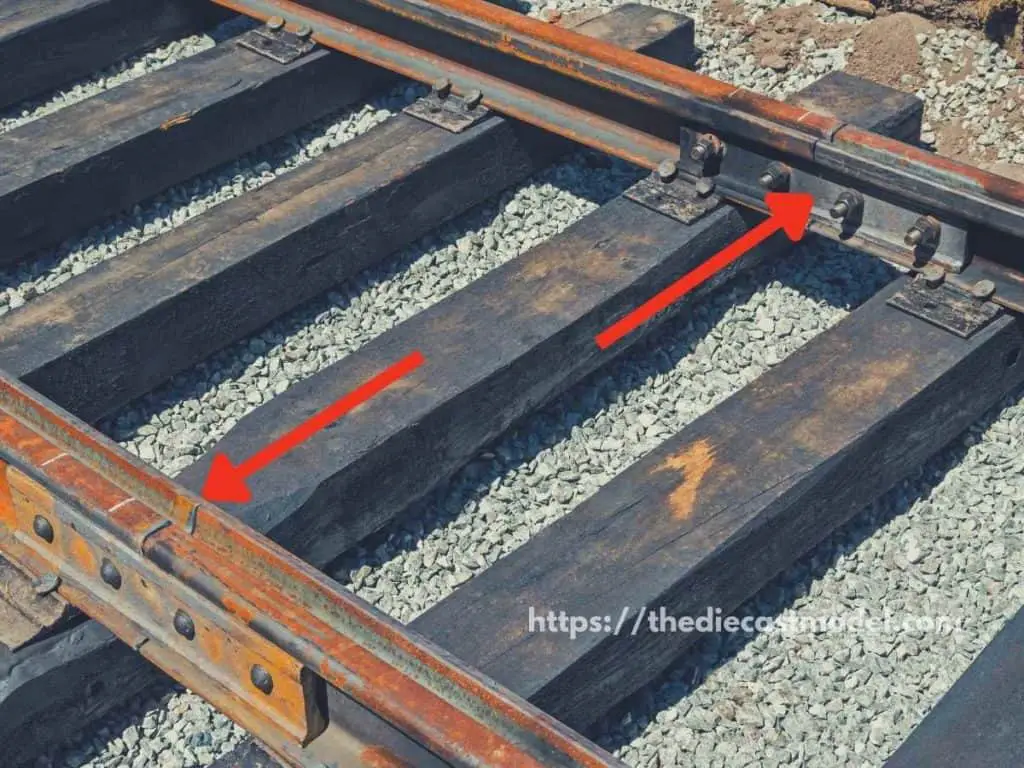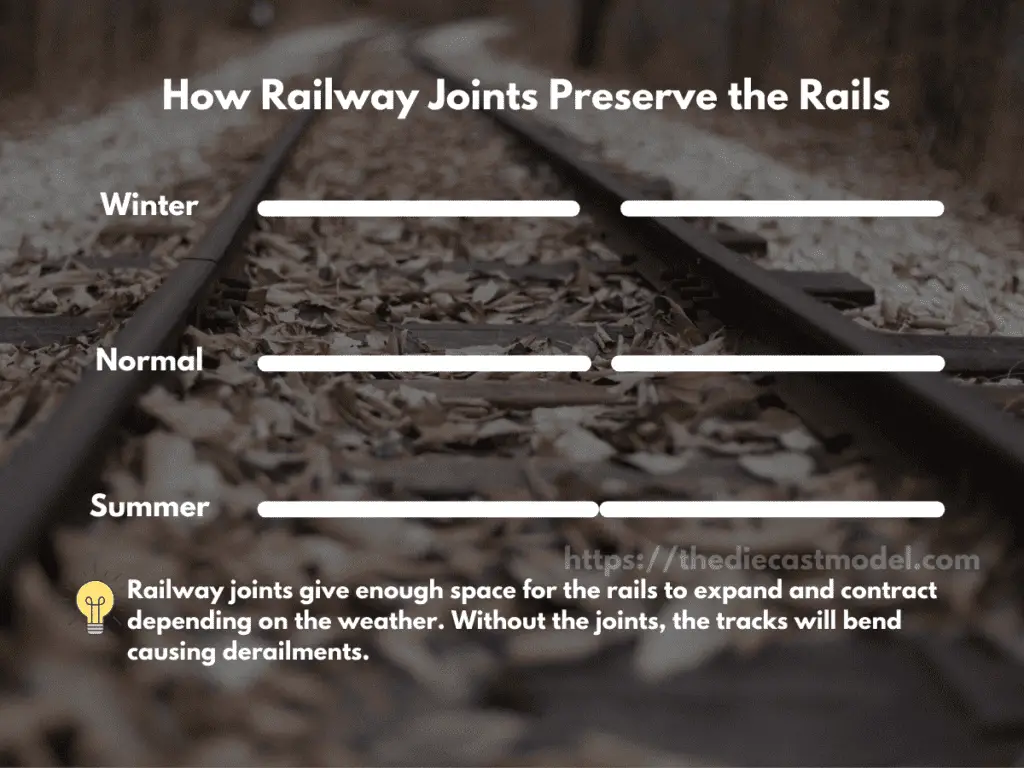Why are Small Spaces or Gaps Left Between Railroad Tracks?
As someone living near a railway station, I can’t help but wonder why there are gaps between rails. Why would something like a railroad, which holds thousands of tons of load, have some gap between them if we need them to be highly durable. Thus, I began researching the purpose of these small spaces.
The small spaces or gaps between the rails allow the rails to contract in cold temperatures and expand in hot temperatures. This simple design prevents derailment caused by the bending of rails due to expansion. This part of the rail is called joints and is often fortified with a fishplate.
This blog post will discuss these small gaps between the rails. What are they called? What is their purpose? What would happen if there were no gaps? I researched and explored these topics, and I would like to share what I found in this post.

What is the space between railway tracks called?
The space between the railway tracks is called joints. The joints are about 1/8″ in length on average, and their function is to serve as a cushion if the rails expand or contract depending on the surrounding temperature. Railway joints prevent accidents whenever the rail changes its length.
First of all, let’s discuss what these spaces are called.
These spaces are called joints.
Depending on the temperature, these joints serve as a cushion if the rails expand or contract.
Generally speaking, the joint’s purpose is to give enough space when the rails expand due to heat in the summer.
You will also notice that these joints are fortified with some heavy bolts and a thick plate. (refer to the picture above)
That thick plate is called a fishplate. This holds the rails and fortifies them since these gaps can easily bend when something as heavy as a train passes through.
If there are no fishplates, these gaps can be a source of problems since they would bend when trains pass through since trains can weigh from 3,000 to 18,000 tons depending on their load.
The fishplate’s purpose is to hold the rails and their joints since they are weak spots on the rails.
Furthermore, the joints tend to get bigger in winter as the temperature drops.
Rail expands during summer and contracts during winter. When it contracts, the gap becomes bigger, making the rail more prone to breaking.
The fishplate allows the joints to remain robust all year round and is an integral part of the joint’s design.
However, there are times when you won’t see fishplates on rails. This is especially true if we are talking about those high-speed rails.
Sadly, fishplates aren’t strong enough to hold rails on our newer high-speed trains.
That’s why you would often see welded rails on these types of train tracks which are more durable than fishplates.
Engineers call this stronger alternative CWR or Continuous Welded Rail.
Please think of the CWR as the upgraded version of the fishplate since it can’t be used on our advanced high-speed trains.
In the next section, I will dive deeper into the function of the joints and why they are there. I also prepared a simple infographic to summarize its function.
Why are gaps left in railway lines?
Gaps are left in railway lines to prevent derailment. This is because railways are made out of steel which is prone to expanding and contracting depending on the outside temperature. Without the gaps, the rails would expand and bend in hot temperatures, which can cause derailments.

You might wonder what’s the big deal with derailments. Derailment is a big problem both for the train passengers and its operators.
For one, derailments can cause delays in the train schedule, affecting a person’s schedule if it is a passenger train or a delayed shipment if it is a cargo train.
Two is that fixing derailments can be pretty expensive. On average, fixing derailments can cost $25,000 and even reach $250,000 for serious ones.
However, these derailments can easily be fixed by putting some joints with fishplates.
Derailments are a big issue in railroading, and we should try to do whatever it takes to experience one.
Recommended Read: As you can see, derailments can be a big issue and should be avoided at all costs. That’s why it is also crucial to know the things on the train tracks that can cause a derailment. For example, can coins, cardboard boxes, or other things cause a train to derail? I made a post discussing the same topic here: Things that are thought to cause derailments.
When I was younger, I thought those joints were there because it would be hard to deliver a huge chunk of rail.
Imagine delivering a very long rail and installing them.
So, I thought that people use these joints because it is easier to assemble rails on-site if they are delivered in small chunks.
After that, they would just join and fortify these rails with fishplates.
However, that is only a bonus since the joint’s primary purpose is to prevent derailments.
But what is the reason why these rails are expanding? What is the science behind it? Can’t we just make rails that aren’t contracting and expanding? We are going to explore these questions next.
What would happen in hot weather if there were no gaps in the track?
Gaps are left between railway tracks to compensate for thermal expansion during summer. Without these gaps, the railway track will expand without any cushion causing it to bend which is dangerous as it dramatically increases the chance of derailment.
Right now, you already understand how important these joints are. While they might be a weakness as they can easily bend, engineers fortified them with fishplates or CWR, eliminating their disadvantage.
However, why do these tracks expand or contract? Can’t we just design a track that doesn’t have these properties?
Well, sadly, we still can’t.
Remember that trains can weigh thousands of tons, and it requires us to use not only highly durable materials but also materials that have extreme tensile strength.
This means being hard is just one part of the equation. In addition, we need the material to be tensile, which means it won’t crack if it bends a little.
Furthermore, we need this material to be inexpensive as we will need a lot to produce tracks that can stretch for miles.
Right now, there is only one material that can do all these things, and that is steel.
Sadly, steel expands and contracts at different temperatures as it is its physical property. However, it is cheap, hard, and has enough tensile strength.
Let me give you an example. I guess almost everyone knows that diamonds are the hardest material on earth.
So, why won’t we use them in rails? One of that they are costly. Imagine how much it would cost to build a track made out of the diamond.
Furthermore, diamonds are hard but aren’t as flexible as steel. This means a slight change can cause it to crack, which is a big no in train operations.
Cement might be extremely cheap and is hard. But it is also prone to cracking.
Until we find a more suitable material than steel, joints would always be part of railroad operations.
Don’t worry. These joints are fortified with thick steel plates, which removes its disadvantage.
What’s next? I am a fan of model trains, and I also researched how long you can run them. Is it 30 minutes, 1 hour, 3 hours, or 5 days? Let’s find the answer plus some tips to make your model trains run longer here: How long can model trains run?






